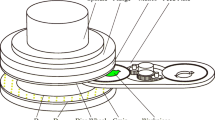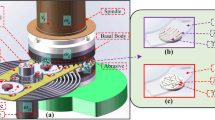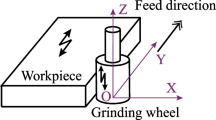Abstract
In double-sided grinding, the material removal on the surface of the workpiece is non-uniform. The thermal deformation of the material may be one of the influencing factors. However, it is difficult to predict and measure the temperature field distribution in the workpiece in double-sided grinding. In this paper, based on the grain trajectory model, a single effective abrasive grain is regarded as a moving point heat source, and the new model of temperature field and workpiece thermal deformation is established based on the thermal–mechanical coupling effect. The distribution characteristics of the temperature field in the workpiece and the axial deformation of the workpiece under different processing parameters are calculated. Finally, a double-sided grinding experiment is carried out to measure the surface profile of the workpiece under different processing parameters to verify the accuracy of the established model. This article solves the problem of the unpredictable temperature field of the workpiece in double-sided grinding and has guiding significance for improving the surface quality of the workpiece in double-sided grinding through the optimization of processing parameters.



















Similar content being viewed by others
Data Availability
All data, models and code generated or used during the study appear in the submitted article.
References
Huo FW, Kang RK, Li Z, Guo DM (2013) Origin, modeling and suppression of grinding marks in ultra precision grinding of silicon wafers. Int J Mach Tools Manuf 66:54–65
Pietsch GJ, Kerstan M (2005) Understanding simultaneous double-disk grinding: operation principle and material removal kinematics in silicon wafer planarization. Precis Eng 29(2):189–196
Hocheng H, Tsai HY, Tsai MS (2000) Effects of kinematic variables on nonuniformity in chemical mechanical planarization. Int J Mach Tools Manuf 40(11):1651–1669
Su JX (2006) Study on material removal mechanism of wafer chemical mechanical polishing in IC manufacturing. PhD thesis, Dalian University of Technology, Deijing
Kasai T (2008) A kinematic analysis of disk motion in a double sided polisher for chemical mechanical planarization (cmp). Tribol Int 41(2):111–118
Kim H, Jeong H (2004) Effect of process conditions on uniformity of velocity and wear distance of pad and wafer during chemical mechanical planarization. J Electron Mater 33(1):53–60
Hu Z, Fang C, Deng W, Zhao Z, Lin Y, Xu X (2017) Speed ratio optimization for ceramic lapping with fixed diamond pellets. Int J Adv Manuf Technol 90(9–12):3159–3169
Wang L, Hu Z, Fang C, Yu Y, Xu X (2018) Study on the double-sided grinding of sapphire substrates with the trajectory method. Precis Eng 51:308–318
Wang Q, Zhang X, Su J, Zhu W, Xi Q, Zhu X, Pei S (2015) Experimental study on chemical mechanical lapping of sic single crystal wafer. Surf Technol 44(4):137–140+146
Zhang D, Li C, Jia D, Wang S, Li R, Qi X (2014) Grinding model and material removal mechanism of medical nanometer zirconia ceramics. Recent Pat Nanotechnol 8(1):2–17
Jamshidi H, Budak E (2020) An analytical grinding force model based on individual grit interaction. J Mater Process Technol 283:116700
Younis M, Sadek MM, El-Wardani T (1987) A new approach to development of a grinding force model. J Eng Ind 109(4):306–313
Usui E (1972) Cutting and grinding. China Machine Press, Beijing
Sun J, Qin F, Chen P, An T (2016) A predictive model of grinding force in silicon wafer self-rotating grinding. International Journal of Machine Tools and Manufacture: Design, research and application 109:74–86
Zhang J, Ge P, Zhang L (2007) Research on the grinding force based on the probability statistics. China Mech Eng 018(020):2399–2402
Jaeger JC (1942) Moving sources of heat and the temperature of sliding contacts. Proc R Soc 76
Steffens K, König W (1983) Closed loop simulation of grinding. CIRP Ann 32(1):255–259
Guo C, Malkin S (1995) Analysis of transient temperatures in grinding. J Eng Ind 117(4):571–577
Rowe WB (2001) Thermal analysis of high efficiency deep grinding. Int J Mach Tools Manuf 41(1):1–19
Wen LK, Lin JF (2006) General temperature rise solution for a moving plane heat source problem in surface grinding. Int J Adv Manuf Technol 31(3–4):268–277
Yan Y, Guo L, Zhang G (2012) Simulation and experimental research of temperature field in ultra-high speed grinding of metallic materials using finite element method. Machine Tool and Hydraulics 40(5):27–31+63
Li HN, Axinte D (2017) On a stochastically grain-discretised model for 2d/3d temperature mapping prediction in grinding. Int J Mach Tools Manuf 116(05):60–76
Deja M, Lichtschlag L, Uhlmann E (2021) Thermal and technological aspects of double face grinding of c45 carbon steel. J Manuf Process 64(7–8):1036–1046
Cooper WL, Lavine AS (2000) Grinding process size effect and kinematics numerical analysis. J Manuf Sci Eng 122(1):59–69
Badger JA, Torrance AA (2000) A comparison of two models to predict grinding forces from wheel surface topography. Int J Mach Tools Manuf 40(8):1099–1120
Gong YD, Wang B, Wang W (2002) The simulation of grinding wheels and ground surface roughness based on virtual reality technology. J Mater Process Technol 129(1–3):123–126
Tönshoff HK, Peters J, Inasaki I, Paul T (1992) Modelling and simulation of grinding processes. CIRP Ann 41(2):677–688
Hokkirigawa K, Kato K (1988) An experimental and theoretical investigation of ploughing, cutting and wedge formation during abrasive wear. Tribol Int 21(1):51–57
Wang D, Ge P, Bi W, Jiang J (2014) Grain trajectory and grain workpiece contact analyses for modeling of grinding force and energy partition. Int J Adv Manuf Technol 70(9–12):2111–2123
Yip FC, Venart JES (1971) An elastic analysis of the deformation of rough spheres, rough cylinders and rough annuli in contact. J Phys D Appl Phys 4(10):1470
Qian L, Yang L, Tian X, Long W, Tang X (2017) Research on scratching force of single diamond grain for 20crmnti. Tool Technol 51(3):22–25
Gao T, Li C, Yang M, Zhang Y, Jia D, Ding W, Debnath S, Yu T, Said Z, Wang J (2021) Mechanics analysis and predictive force models for the single-diamond grain grinding of carbon fiber reinforced polymers using cnt nano-lubricant. J Mater Process Technol 290:116976
Sharp KW, Miller MH, Scattergood RO (2000) Analysis of the grain depth-of-cut in plunge grinding. Precis Eng 24(3):220–230
Hahn RS (1962) On the nature of the grinding process. In Proceedings of the 3rd International Machine Tool Design & Research Conference, Manchester pp. 129–154
Zhang X, Lin B, Xi H (2013) Validation of an analytical model for grinding temperatures in surface grinding by cup wheel with numerical and experimental results. Int J Heat Mass Transf 58(1–2):29–42
Hou Z, He S, Li N (1984) Heat Conduced of Solid. Shanghai Science and Technology Press, Shanghai
Ruan D (1999) Heat conduction due to moving heat sources in semi-infinite body. J Chongqing Univ (Natural Science Edition) 22(1):66–71
Wang R, Dai S, Zhang H, Dong Y (2017) The temperature field study on the annular heat source model in large surface grinding by cup wheel. Int J Adv Manuf Technol 93(9):3261–3273
Li Q, Xiu S, Yao Y, Sun C, Zheng S (2020) Study on surface material removal uniformity in double side grinding based on grain trajectories. Int J Adv Manuf Technol 107(5):2865–2873
Funding
This project is supported by National Natural Science Foundation of China (Grant No. 52175383 and Grant No. 51775101).
Author information
Authors and Affiliations
Contributions
Qingliang Li and Xiangna Kong proposed the ideas and established the simulation model, and Cong Sun and Yunlong Yao designed the experimental plan. The measurement was performed by Qingliang Li and Cong Sun. Qingliang Li, Yunlong Yao and Xiangna Kong processed and analyzed the experimental data. Qingliang Li wrote the original draft and Shichao Xiu supervised the project and reviewed and edited the article.
Corresponding author
Ethics declarations
Conflicts of interest
All authors certify that they have no affiliations with or involvement in any organization or entity with any financial interest or non-financial interest in the subject matter or materials discussed in this manuscript.
Ethics approval
Not applicable
Consent to participate
Not applicable
Consent for publication
Not applicable
Additional information
Publisher’s Note
Springer Nature remains neutral with regard to jurisdictional claims in published maps and institutional affiliations.
Rights and permissions
About this article
Cite this article
Li, Q., Xiu, S., Sun, C. et al. Analysis of the uniformity of material removal in double-sided grinding based on thermal–mechanical coupling. Int J Adv Manuf Technol 119, 3363–3375 (2022). https://doi.org/10.1007/s00170-021-08457-6
Received:
Accepted:
Published:
Issue Date:
DOI: https://doi.org/10.1007/s00170-021-08457-6




